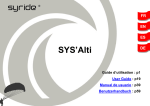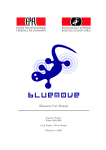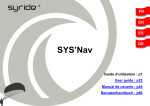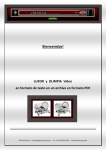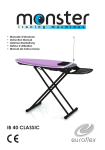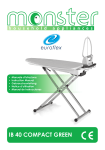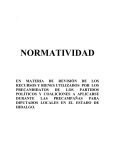Download DeLonghi Pressurized steam cleaner User manual
Transcript
5793106200/03.05 Limpia superficies mediante vapor a presión Pressurized steam cleaner Manual de instrucciones Instructions for use ESPAÑOL Distinguido cliente, Alegrándonos por su elección, le agradecemos la confianza que nos ha dado. Nuestros productos son el resultado de minuciosos testes técnicos y de un estudio profundizado. Hemos preparado este manual de uso para permitir utilizar de la manera mejor el producto y para apreciar todas sus cualidades. Estamos seguros que, siguiendo nuestras sugerencias, podrá utilizarlo durante mucho tiempo y con los mejores resultados. Aprovechando la fuerza del vapor, Usted contribuirà a reducir la contaminación resultante de la dispersión de detergentes químicos. Este aparato aprovecha la potencia del vapor como ayuda en las operaciones diarias de la limpieza de la casa y en el ámbito del jardín, hobby y bricolaje. Ha sido estudiado para obtener la máxima higiene de las superficies y del papel de empapelar. Por lo tanto una ayuda de gran valor para las tareas domésticas de todos los días. ADVERTENCIAS PARA LA ELIMINACIÓN CORRECTA DEL PRODUCTO SEGÚN ESTABLECE LA DIRECTIVA EUROPEA 2002/96/CE. Al final de su vida útil, el producto no debe eliminarse junto a los desechos urbanos. Puede entregarse a centros específicos de recogida diferenciada dispuestos por las administraciones municipales, o a distribuidores que facilitan este servicio. Eliminar por separado un electrodoméstico significa evitar posibles consecuencias negativas para el medio ambiente y la salud derivadas de una eliminación inadecuada y permite reciclar los materiales que lo componen, obteniendo así un ahorro importante de energía y recursos. Para subrayar la obligación de eliminar por separado los electrodomésticos, en el producto aparece un contenedor de basura móvil tachado. 2 Descripción 1 4 6 7 5 2 17 3 9 Accesorios 11 8 12 1. Regulador del flujo de vapor (en los modelos donde está previsto) 2. Interruptor general con luz indicadora 3. Interruptor del generador de vapor 4. Empuñadura 5. Tapón de la caldera 6. Luz indicadora generador de vapor 7. Luz indicadora de encendido del aparato. 17. Manómetro (en los modelos donde está previsto) 10 14 16 15 13 3 8. Tubo flexible con empuñadura (en algunos modelos extraìble) 9. Lanza 10. Cepillo triangular 11. Dos tubos rígidos de prolongación 12. Cepillo para lanza 13. Trapo para el cepillo alfombras/suelos y para el cepillo triangular 14. Cepillo alfombras/suelos 15. Accesorio limpiacristales 16. Plancha (donde está previsto) Advertencias 1) 2) 3) 4) 5) 6) 7) 8) 9) 10) 11) 12) 13) 14) 15) 16) 17) 18) 19) 20) 21) 22) 23) 24) 25) Leer atentamente las instrucciones El aparato en funcionamiento contiene vapor bajo presión: un uso indebido puede resultar peligroso. El aparato está destinado a un uso doméstico y al uso en el ámbito del jardín, hobby y bricolaje; se excluye cualquier utilización de tipo industrial. La sociedad productora rechaza cualquier responsabilidad por eventuales daños derivados por un uso impropio del producto. No deje la plancha enchufada a la corriente sin vigilancia. Desconectar siempre el enchufe antes de empezar a llenar el depósito de la caldera o antes de seguir cualquier manutención o limpieza del propio aparato. Antes del uso verificar que la tensión de la red corresponde con la que se indica en la placa de datos colocada debajo del aparato. Conectar el aparato a una toma de corriente con un alcance mínimo de 10 A y dotada de una toma de tierra eficaz. No dirigir nunca el chorro de vapor hacia tomas de corriente o partes bajo tensión eléctrica: podrían dañarlas y exponerse a escargas eléctricas peligrosas. No dirigir nunca el chorro de vapor hacia el aparato. No tirar el cable de alimentación o del aparato para desconectar el enchufe de la toma de corriente. No pasar el aparato sobre el cable eléctrico, a fin de evitar dañar el aislamiento. No ponga el aparato en posición vertical. NO ABRA EL TAPÓN DURANTE LA UTILIZACIÓN DEL APARATO Y ANTES DE QUE EL APARATO HAYA AGOTADO COMPLETAMENTE EL AGUA. Lo cual se produce cuando el vapor deja de salir por la plancha o por los accesorios. Para añadir agua, extraiga la clavija, espere aproximadamente 15 minutos para evitar bruscos cambios de temperatura. Envuelva el tapón con el trapo y desenrosque éste despacio para permitir que el vapor residual salga lentamente. Antes de limpiar con el vapor objetos que funcionan con corriente eléctrica o aparatos electrodomésticos (horno eléctrico, frigorífico, campana extractora, etc.). Antes de todo desconectar estos aparatos de la red eléctrica. Antes de volverlos a conectar, esperar a que todo esté perfectamente seco, ya que restos de agua podrían causar descargas eléctricas. Evitar el contacto del vapor con la piel. La elevada temperatura puede causar graves quemaduras. No dirigir nunca el chorro de vapor hacia personas o animales, hacia objetos o superficies no resistentes a tales temperaturas. Para cambiar de lugar el aparato, agárrelo por la empuñadura específica; al contener una caldera, su superficie se calienta durante la utilización. Las personas que padecen de determinadas patologías de sensibilidad al calor tienen que tener especial cautela en el uso de este aparato. No introducir ningún detergente en el depósito. Utilizar exclusivamente agua. Si el aparato no se utiliza durante largos periodos, les aconsejamos que hagan evaporar toda el agua antes de guardarlo. Utilice sola y EXCLUSIVAMENTE la alfombrita apoya plancha suministrada en dotación; en caso de pérdida (o si se estropea) utilice solamente el repuesto ORIGINAL. No poner la plancha en posición vertical. Mantener alejado el aparado del alcance de los niños o de personas que no estén en condiciones de utilizarlo sin control. Una vez se ha terminado de planchar, dejar enfriar la plancha antes de guardarlo. No poner en funcionamiento el aparato que parezca defectuoso. Diríjase al Centro de Asistencia autorizado. En caso de accionamiento del limitador de la temperatura de seguridad, la plancha o el dispositivo deja de funcionar. Para volver a ponerlo en funcionamiento, diríjase a personal especializado. No dejar el aparato expuesto a agentes atmosféricos (lluvia, hielo, sol, etc.) Para efectuar reparaciones póngase en contacto con el Centro de Asistencia autorizado, para no alterar la eficacia de su aparato y para garantizar la validez de la garantía. Si el cable de alimentación está estropeado, el fabricante o su servicio de asistencia técnica, o en cualquier caso, una persona con una cualificación similar deberá sustituirlo para eliminar cualquier riesgo. CONSERVAR CUIDADOSAMENTE ESTAS INSTRUCCIONES 4 Montaje y preparación para el uso Uso de la caldera Antes de iniciar cualquier manutención o preparación del aparato, asegúrense de que el enchufe esté desconectado. Para abrir la caldera ejercer una presión sobre el tapón de seguridad girándolo. Les aconsejamos llenar el depósito con una cantidad máxima de 1,5 litros de agua del grifo (una cantidad mayor podría causar un mal funcionamiento del aparato). Enroscar el tapón, ejerciendo una presión enroscando hasta el fondo. Preparación de los accesorios de limpieza Modelos con tubo extraìble Para conectar el tubo flexible a la máquina: * introducir en la toma el tubo flexible apoyando hasta oír el clic de introducción * verificar si el tubo se introduce en la toma. Para sacarlo, apretar el pulsador y tirar hacia sí. Todos los modelos Los accesorios para la limpieza se introducen en uno o dos tubos rígidos de prolongación según las necesidades. En cualquier caso hay que proceder del siguiente modo: * coger en una mano la pieza en la que irá introducido el accesorio, y con el dedo pulgar de la misma mano apretar el pulsador; * con la otra mano, introducir el accesorio y hacer que se deslice con cuidado sobre el pulsador hasta cuando este último haya salido del orificio colocado en el accesorio. 5 Para sacar un accesorio, efectuar la operación inversa. Sacar con cuidado el accesorio teniendo cuidado en no pellizcar el dedo que empuja el pulsador. 2 7 6 Funcionamiento del aparato 3 Introducir el enchufe en la toma eléctrica, encender el interruptor general (2), la luz indicadora se enciende y la caldera se pone en funcionamiento accionando el interruptor general del vapor (3). En los modelos con manómetro, cuando la aguja del manómetro se encuentra en la zona verde, el aparato está listo para el uso y la luz indicadora se apaga (7). Esperar unos 15 minutos, cuando la luz indicadora se apaga (7) el aparato está listo para el uso. Para la salida del vapor pulse el botón (1) y después la palanca (2) (fig. 5). Cuando se deje la palanca (2) sobre la empuñadura, la emisión del vapor acabará de inmediato. 2 1 NB:Cuando se utilice por primera vez, el aprato puede emanar durante algunos minutos humo y olor debido al recalentamiento y consecuente secado de los sigilos utilizados en el ensamblaje de la caldera. Airear la habitación. 6 Consejos de utilización para la limpieza Alfonbras y moquetas Advertencias: * verificar la resistencia de los tejidos y de los colores en puntos escondidos * se aconseja aspirar antes el polvo con un aspirador o con una aspiradora para alfombras Advertencias * testar siempre la resistencia de los tejidos o de los colores en un punto escondido * se aconseja aspirar antes el polvo con un aspirador Accesorios: cepillo alfombras/suelos + trapo fijado con los ganchos con muelle. Regulación del vapor: posición central Sillones, sofás, cojines, colchones, interior del coche, persianas, paredes verticales, muebles de jardín, templetes, sombrillas de jardín y balancines. Accesorios: cepillo triangular + trapo fijado con los ganchos con muelle Regulación del vapor: posición central Suelos Accesorios: cepillo alfombras/suelos + trapo fijado con los ganchos con muelle Regulación del vapor: máximo Advertencias * No se aconseja el uso sobre baldosas de barro cocido tratado, sobre suelos encerados o sobre parquet Juntas de las baldosas, radiadores, persianas, jambas de las puertas, puntos de difícil acceso, floreros, bicicletas, bicicletas de montaña, motores de los coches, motos, herramientas de jardinería (cortadoras de hierba), juegos de niños (columpios). Accesorios: lanza + cepillo Regulación vapor: máximo 7 Baño (mampara de la ducha, sanitarios, pilas, piscinas). Accesorios: lanza + cepillo directamente en el tubo flexible o en el tubo rígido de prolongación Regulación del vapor: máximo Espejos, ventanas, cristales del coche, galerías e invernaderos. Accesorios: tubos rígidos de prolongación + rastrillo Regulación del vapor: mínimo Advertencias: * cuando fuera hace frío, atención a los cambios de temperatura, que podrían romper los cristales. Éstos tienen que ser calentados con un ligero chorro de vapor. Llenado de la caldera Cuando el vapor se agota, se puede proceder al llenado de la caldera, siguiendo el siguiente método: Abrir el tapón sólo cuando el agua se haya evaporado totalmente. Hacer salir todo el vapor, utilizando el interruptor colocado en la empuñadura o el pulsador para la salida de vapor de la plancha. Apagar el aparato actuando sobre el interruptor general (2) o sacando el enchufe de la toma eléctrica. Esperar algún minuto antes de volver a llenar el depósito para evitar repentinos cambios de temperatura. Poner el trapo encima del tapón del depósito para evitar repentinos cambios de temperatura. Poner el trapo encima del tapón del depósito (6) para abrirlo. Abrir despacio el tapón poniendo atención en hacer salir lentamente el vapor que podría quedar en el interior. Llenar de nuevo el depósito siguiendo las explicaciones precedentes. 8 Uso de la plancha (si es suministrada) Para la puesta en funcionamiento de la caldera, seguir las instrucciones dadas precedentemente. Preparación del sistema de planchado Para conectar la plancha con el aparato: Introducir en la toma el dispositivo de la plancha, ejercer una presión para hacer saltar el pulsador de extracción; verificar que el dispositivo esté bien introducido intentando sacarlo sin actuar sobre el pulsador de extracción. Para poner en funcionamiento el aparato, seguir las instrucciones dadas precedentemente. Cuando la plancha se utiliza por primera vez, se aconseja hacer salir el vapor sobre un trapo durante algún segundo, para eliminar posibles impurezas que podrían depositarse en el interior de la plancha. Con este fin, accionar el pulsador “petición de vapor” colocado en la parte superior de la plancha. NB:Cuando se utilice por primera vez, el aprato puede emanar durante algunos minutos humo y olor debido al recalentamiento y consecuente secado de los sigilos utilizados en el ensamblaje de la caldera y de la plancha. Airear la habitación. Funcionamiento Seleccione la temperatura deseada, girando el regulador del termostato en uno de los sectores disponibles, de acuerdo con el tipo de tejido que hay que planchar. Antes de comenzar a planchar, espere a que se apague la luz testigo “plancha en temperatura” puesta su la plancha. N.B.: la luce piloto se encenderá y apagará durante el planchado, de acuerdo con las temperaturas alcanzadas por la caldera y la plancha. Para erogar el vapor, apriete el botón vapor situado en la plancha. Actuar sobre el regulador del flujo de vapor (1) para obtener la cantidad de vapor deseada. Nota: En el momento del encendido, es aconsejable tener situado el regulador en la posición de erogación máxima del vapor. ATENCIÓN: El tubo de conexión plancha-caldera puede calentarse. La planche puede generar vapor incluso en posición vertical; esto permite vaporizar los tejidos con facilidad para recobrar su aspecto de nuevo. Planchado en seco Encienda sólo el interruptor general (2) y deje apagado el interruptor del generador de vapor (3) que se encuentra en la unidad central del aparato. Antes de comenzar el planchado, aguarde hasta que la luz testigo de la plancha se haya apagado. 9 A Consejos útiles ✔ Tejidos de terciopelo, lana, etc., así como guantes, bolsas, etc. podrán recuperar su aspecto y suavidad originales, pasando lentamente la plancha a poca distancia de los mismos con el vapor en funcionamiento. ✔ Las alfombras podrán quedar como nuevas, eliminando los hoyos de los muebles apoyados sobre las mismas, haciendo penetrar el vapor en donde el pelo está aplastado y luego cepillando ligeramente. ✔ No apoye ni use la plancha sobre cremalleras, ganchos, anillas, etc., para no rayar la suela. ✔ Mantenga limpia la superficie de la suela: con dicho fin, es suficiente pasar un paño húmedo sobre la superficie fría. No limpie el aparato con descalcificadores. ✔ Cuando deje de usar la plancha, espere siempre a que se enfríe antes de guardarla. ✔ Guarde la plancha en un lugar seco. ✔ No es necesario vaciar el agua que queda en la caldera cuando termine de planchar. ✔ Divida las prendas de acuerdo con la temperatura requerida para el planchado, comenzando con aquéllas que requieren las temperaturas más bajas. ✔ Los tejidos de seda se planchan en seco y sobre el revés. ✔ Los tejidos de lana, algodón y lino se planchan con vapor sobre el revés, o sobre el derecho interponiendo una tela fina para evitar el efecto de “brillos”. Los tejidos almidonados requieren más humedad. Planche sobre el derecho del tejido los colores blancos y claros y sobre el revés los colores oscuros y los bordados, para hacerlos resaltar. ✔ Los tejidos de lino se planchan con vapor, vaporizando abundantemente y planchando sobre el revés sólo los tejidos oscuros, para evitar el efecto de “brillos”. Planche los dobleces sobre el derecho, para darles más resalte. ✔ Cada vez que use el vapor (y cuando lo use por primera vez), o si no ha utilizado el vapor por algunos minutos, apriete varias veces el botón del vapor. Esto permitirá eliminar el agua fría del circuito del vapor. 10 Tabla para un planchado perfecto Acetato - Acrílico - Nailon • PLANCHADO EN SECO MUY LIGERO Poliéster - Rayón • PLANCHADO EN SECO SOBRE EL REVÉS DE LA PRENDA A TEMPERATURA MÍNIMA Seda •• PLANCHADO EN SECO SOBRE EL REVÉS DE LA PRENDA Lana - Algodón Fino - Lino fino •• PLANCHADO EN VAPOR SOBRE EL REVÉS DE LA PRENDA USANDO UNA TELA DELGADA ENCIMA DE LOS TEJIDOS Algodón - Lino fino - Tejidos almidonados ••• PLANCHADO DE VAPOR SOBRE EL DERECHO DE LAS PRENDAS BLANCAS O CLARAS Y SOBRE EL REVÉS DE LAS PRENDAS OSCURAS Lino ••• PLANCHADO DE VAPOR VAPORIZANDO ABUNDANTEMENTE SOBRE EL REVÉS DE LOS TEJIDOS OSCUROS 11 ENGLISH Dear customer Congratulations on your purchase and thank for your confidence in our brand. Our products represent the fruit of rigorous testing and in-depth study. We have prepared this user manual to enable you to get the most out of the product. We are sure that compliance with the instructions will ensure the lenghty service life of the appliance and your lasting satisfaction. By exploiting the power of steam, it helps reduce air pollution caused by the dispersion of chemical detergents. This appliance exploits the power of steam to facilitate everyday cleaning in the home or for gardening, hobbies and DIY. It has been designed to improve the hygiene of household surfaces and upholstery. When fitted with an iron, this product constitutes an efficient ironing system capable of meeting all the family’s requirements. Consequently, it represents a valuable helping hand in everyday household tasks. IMPORTANT INFORMATION FOR CORRECT DISPOSAL OF THE PRODUCT IN ACCORDANCE WITH EC DIRECTIVE 2002/96/EC. At the end of its working life, the product must not be disposed of as urban waste. It must be taken to a special local authority differentiated waste collection centre or to a dealer providing this service. Disposing of a household appliance separately avoids possible negative consequences for the environment and health deriving from inappropriate disposal and enables the constituent materials to be recovered to obtain significant savings in energy and resources.As a reminder of the need to dispose of household appliances separately, the product is marked with a crossed-out wheeled dustbin. 12 Description 1 4 6 7 5 2 17 3 1. Steam flow regulator (where this is one of the model’s features) 2. Illuminated on/off switch 3. Steam generator switch 4. Handle 5. Filler cap 6. Steam generator light 7. Appliance operating light 17. Pressure gauge (where this is one of the model’s features) 9 Accessories 11 8 12 10 14 16 15 13 13 8. Flexible hose with handgrip (some models are provided with detachable hose) 9. Nozzle 10. Triangular brush 11. Two rigid extension tubes 12. Mini-brush for nozzle 13. Wash cloth for the carpet/floor brush and for the triangular brush 14. Carpet/floor brush 15. Window-cleaning squeegee 16. Iron (some models only) Important 1) 2) 3) 4) 5) 6) 7) 8) 9) 10) 11) 12) 13) 14) 15) 16) 17) 18) 19) 20) 21) 22) 23) 24) 25) Read the instructions carefully The appliance contains pressurised steam. Incorrect or improper use could be dangerous. The appliance is designed for household use or for gardening, hobbies or DIY. All types of industrial use are excluded. The manufacturer declines all liability for damage deriving from improper use of the product. Do not leave the iron unattended when plugged in. Always disconnect the plug before filling the boiler tank, or before carrying out any maintenance Always unplug before filling the boiler tank, performing maintenance or cleaning the appliance. Before use, make sure the mains voltage corresponds to the voltage indicated on the rating plate on the bottom of the appliance. Plug the appliance into an efficiently earthed socket with a minimum rating of 10 A. Never direct the steam jet towards the socket or live parts: they could be damaged, with the risk of dangerous electrical discharges. Never direct the steam jet towards the appliance. Never unplug the appliance by pulling the power cable or appliance itself. To avoid damaging the insulation, do not run the appliance over the power cable. Never place the appliance in a vertical position. DO NOT OPEN THE CAP WHILE USING THE APPLIANCE OR BEFORE ALL THE WATER HAS BEEN EXHAUSTED. THIS OCCURS WHEN STEAM IS NO LONGER DISCHARGED BY THE IRON OR TOOLS. To add water, unplug and wait about 15 minutes to avoid sudden temperature changes. Place the cloth over the cap and unscrew slowly to allow residual steam to escape slowly. Before steam cleaning electrically-powered objects or household appliances (electric oven, refrigerator, extractor fan, etc), unplug these appliances from the mains. Before plugging in again, make sure they are perfectly dry as residual water could cause electrical discharges. Avoid the steam coming into contact with the skin. The high temperature could cause serious burns. Never direct the steam jet towards persons or animals or towards surfaces or objects with could be damaged by high temperatures. To move the appliance, hold it by the handgrip. As it contains a boiler, its surfaces become hot during use. Persons affected by particular pathologies causing abnormal sensitivity to heat should take special care when using this appliance. Do not add detergent to the tank. Use water only. If not used for long periods, you are recommended to evaporate the water completely before putting the appliance away. Use the iron mat provided ONLY. If it is lost or damaged, use only an ORIGINAL replacement. Never place the iron in a vertical position. Keep the appliance out of reach of children or persons not capable of using it without supervision. After ironing, allow the plate of the iron to cool before putting away. Do not use the appliance if it appears to be faulty. Contact the authorised surface centre. If the temperature safety switch trips, the iron or device shuts down. To use again, contact specialist personnel. Protect the appliance from atmospheric agents (rain, frost, sun, etc). To repair contactan authorised service centre in order to avoid compromising the efficiency of your appliance and guarantee the validity of the guarantee. For the same reasons, you are always recommended to use original spare parts. If the supply cord is damaged, it must be replaced by the manufacturer, its service agent or similarly qualified persons in order to avoid a hazard. KEEP THESE INSTRUCTIONS CAREFULLY 14 Assembling and preparing for use Using the boiler Before commencing any maintenance, or preparing the appliance for use, make sure that the plug is disconnected. In order to open the boiler, press down on the safety cap and turn at the same time. It is advisable to fill the tank with a maximum of 1,5 litres of tap water (greater quantities may result in the appliance’s poor operation). Screw on the tap, applying pressure and screwing down tight. P repari ng the accessories cl eani ng Models with detachable flexible hose In order to connect the flexible hose to the unit: * insert the flexible hose in the socket, applying slight pressure until you hear it click in * check whether the hose is in the socket. In order to remove it, press the button and pull it towards you. All models The cleaning accessories must be inserted into one or two of the rigid extension tubes, depending on the requirements. Whetever the case, the procedure is as follows: * hold the part, into which the accessory is to be inserted, in one hand, and press the button using the thumb of that hand; * with the other hand insert the accessory and slide it carefully over the button until the button emerges from the orifice on the accessory. 15 In order to disconnect the accessory, follow the reverse procedure. Remove the accessory carefully, taking care not to catch your finger which is holding the button down. 2 7 6 Operating the appliance Plug the appliance in, turn on the on/off switch (2), the light comes on and the boiler starts working, activating the main steam switch (3). 3 Wait approx. 15 minutes; when the light (6) goes off the appliance is ready for use. Press the switch located on the handgrip of the flexible hose in order to shoot the steam out of the accessories. To produce steam, press the button (1) and then the lever (2). When the lever (2) on the handgrip is released, steam discharge ceases immediately. 2 1 N.B.: When used for the first time, the appliance may give out smoke and an odour for several minutes. This is caused by heating and subsequent drying of the sealers used in assembling the boiler. You are recommended to ventilate the room. 16 Cleaning advice Rugs and carpets Warning: * check the resistance of fabrics or colours in places which can not be readily seen * it is advisable to remove dust using a vacuum cleaner before starting Accessories: carpet/floor brush + wash cloth held on by the snap hooks. Steam setting: central position. Armchairs, sofas, cushions, mattresses, car interiors, blinds, vertical walls, garden furniture, gazebos, garden umbrellas and loungers. Warning: * check the resistance of fabrics or colours in places which can not be readily seen * it is advisable to remove dust using a vacuum cleaner before starting Accessories: triangular brush + wash cloth held on by the snap hooks Steam setting: central position Floors Accessories: carpet/floor brush + wash cloth held on by the snap hooks Steam setting: maximum Warning: * it is not advisable to use the appliance on treated terra-cotta tiles, on waxed floors or on woodblock flooring. Joints between tiles, radiators, shutters, door jambs, difficult to reach points, flower pots, bicycles, mountain bikes, car engines, m o t o rc yc le s, g a rd e n e q u ip me n t (lawnmowers), children's games (swings) Accessories: nozzle + mini-brush Steam setting: maximum 17 Bathroom (shower cubicle, sanitary fittings, basins, swimming pools) Accessories: nozzle + mini-brush directly on flexible hose or on the rigid extension tube Steal setting: maximum Mirrors, windows, car windows, verandas, greenhouses Accessories: rigid extension tubes + raclette Steam setting: minimum Warning * when it is cold outside, take care to avoid sudden changes in temperature which could break the glass. The glass should be heated with a slight jet of steam. Filling the boiler When the steam has run out, the boiler can be filled by following the procedure below: Only open the cap once all the water has evaporated Let all the steam escape, using the switch on the handgrip, or the button for expelling steam from the iron. Turn the appliance off using the on/off switch (2), or pull the plug out from the socket. Wait for a few minutes before filling the tank again in order to avoid sudden changes in temperature. Place the cloth over the filler cap (5) to open it. Open the cap slowly, taking care to allow any steam, which might still be inside, to escape gradually. Fill the tank again by following the procedure explained previously. 18 Using the iron (if provided) To operate the boiler, see the above instructions. Setting up the ironing system To connect the iron to the appliance: Plug the iron into the socket and press until the release button clicks. Make sure the plug is fully inserted by attempting to remove it without using the release button. To turn on the appliance, follow the above instructions. When the iron is started up for the first time, you are recommended to discharge the steam onto a cloth for a moment in order to eliminate possible impurities deposited in the iron. Do this by pressing the "steam required" button on top of the iron. N.B.: When used for the first time, the appliance may give out smoke and an odour for several minutes. This is caused by heating and subsequent drying of the sealers used in assembling the boiler. You are recommended to ventilate the room. OPERATION Select the required temperature by rotating the thermostat knob to one of the marked sectors according to the type of fabric to be ironed. Wait until the "iron at temperature" indicator light goes out before beginning to iron. N.B.: the indicator light goes on and off during ironing according to the temperature of the iron. To discharge steam, use the steam button on the iron. Use the steam flow regulator (1) to obtain the required quantity of steam. N.B. When turning the iron on, you are recommended to rotate the knob into the maximum steam discharge position. IMPORTANT: the tube connecting the iron to the boiler may become hot. The iron can also generate steam in a vertical position, enabling fabrics to be easily restored by steaming. Dry ironing Turn on the main switch (2) only and leave the steam generator switch (3) on the appliance control unit in the off position. Wait for the indicator light on the iron to go off before starting to iron. required quantity of steam. 19 A Tips for perfect ironing. ✔ The original appearance and softness of velvet, wool or similar materials as well as glove and bags etc. can be restored by holding the iron a few cm above the fabric whilst pressing the steam button (A). ✔ Carpets and rugs can be restored to new, eliminating the marks made by furniture, by allowing the steam to penetrate into the squashed pile and brushing lightly. ✔ Do not rest or use the iron on zips, hooks, rings etc to avoid scratching the plate. ✔ Keep the surface of the plate clean: to clean, wipe the cold surface with a damp cloth. ✔ Descaling products must not be used in the iron. ✔ After use, always wait until the iron is cold before putting away. ✔ Store the appliance in a dry place. ✔ After ironing, the water remaining in the boiler need not be drained. ✔ Silk fabrics can be dry-ironed on the wrong side. ✔ .Divide garments according to required ironing temperature, starting with those requiring the lowest temperatures. ✔ Wool, cotton and linen fabrics can be steam-ironed on the wrong side, or on the right side over a fine cloth to avoid the "shiny" effect. Starched fabrics require greater moisture. Iron white and light coloured fabrics on the right side and dark colours on the wrong side. Embroidery should also be ironed on the wrong side to make it stand out. ✔ Linen fabrics can be steam ironed by steaming abundantly and ironing dark fabrics only on the wrong side to avoid a "shiny" effect. Iron cuffs and lapels on the right side to make them stand out. ✔ Every time the iron is used (including for the first time) or if you have not used the iron for several minutes: push the steam button several times. This enables the cold water to be eliminated from the steam circuit. 20 Perfect ironing table Acetate - Acrylic - Nylon • DRY IRON, VERY LIGHTLY Polyester - Rayon • DRY IRON ON REVERSE SIDE OF GARMENT AT MINIMUM TEMPERATURE Silk •• DRY IRON ON REVERSE SIDE OF GARMENT Wool - Fine Cotton - Fine Linen •• STEAM IRON ON REVERSE SIDE OF GARMENT PLACING A THIN CLOTH OVER THE FABRIC Cotton - Fine Linen - Starched Articles ••• STEAM IRON ON FRONT OF WHITE OR LIGHT COLOURED GARMENTS, ON REVERSE SIDE OF DARKER ARTICLES Linen ••• STEAM IRON WITH PLENTY OF STEAM ON REVERSE SIDE OF DARK GARMENTS. ELECTRICAL CONNECTION (UK ONLY) A) If your appliance comes fitted with a plug, it will incorporate a 13 Amp fuse. If it does not fit your socket, the plug should be cut off from the mains lead, and an appropriate plug fitted, as below. WARNING: Very carefully dispose of the cut off plug after removing the fuse: do not insert in a 13 Amp socket elsewhere in the house as this could cause a shock hazard. With alternative plugs not incorporating a fuse, the circuit must be protected by a 15 Amp fuse. B) If the plug is a moulded-on type, the fuse cover must be re-fitted when changing the fuse using a 13 Amp Asta approved fuse to BS 1362. In the event of losing the fuse cover, the plug must NOT be used until a replacement fuse cover can be obtained from your nearest electrical dealer. The colour of the correct replacement fuse cover is that as marked on the base of the plug. If your appliance is not fitted with a plug, please follow the instructions provided below: As the colours of the wires in the mains lead may not correspond with the coloured markings identifying the terminals in your plug, proceed as follows: The green and yellow wire must be connected to the terminal in the plug marked with the letter E or the earth symbol or coloured green or green and yellow. The blue wire must be connected to the terminal marked with the letter N or coloured black. The brown wire must be connected to the terminal marked with the letter L or coloured red. WARNING - THIS APPLIANCE MUST BE EARTHED IMPORTANT The wires in the mains lead are coloured in accordance with the following code: E Green and yellow: Earth Blue: Neutral L N Brown: Live 21
This document in other languages
- español: DeLonghi Pressurized steam cleaner






















